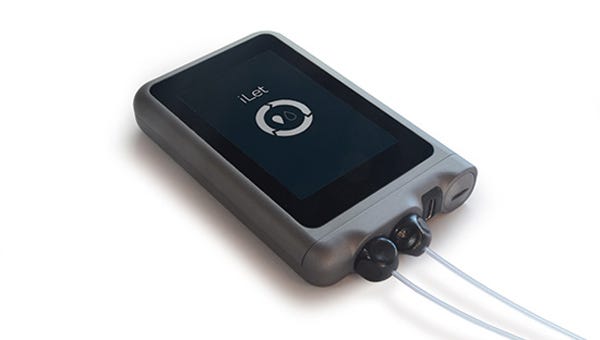These Parents Are Tired of Waiting for Medtech, FDA
May 9, 2016
Frustrated parents of kids with type 1 diabetes are going the do-it-yourself route, and making their own artificial pancreases.
Nancy Crotti
|
Parents of diabetic children are the force behind the dual-chamber bionic pancreas dubbed the iLet. (Image courtesy of Boston University) |
Frustrated with how long it's taking FDA to approve any manufacturer's artificial pancreas, parents of children with type 1 diabetes are taking matters into their own hands.
The Wall Street Journal reports that about 50 tech-savvy folks have modified old insulin pumps to automatically provide insulin, based on the patient's blood-sugar level. It's not a new phenomenon. Parents and adult patients have been sharing information online about how to hack into existing pumps to create their own devices.
Too much blood glucose can lead to blindness and kidney failure. When blood glucose levels fall too low (hypoglycemia), patients may suffer confusion, disorientation, loss of consciousness, coma, or seizure. Keeping hypoglycemia at bay overnight is a high priority, especially for parents of children who have the disease.
A number of medtech companies are working on developing an artificial pancreas. Medtronic billed its MiniMed 530G, approved by FDA in 2013, as the first artificial pancreas. It automatically ceases basal insulin delivery for up to two hours if a patient does not respond to an alarm triggered when sensor glucose values drop below a preset level. Wearers still have to do four finger sticks per day to measure their blood glucose.
Johnson & Johnson subsidiary Animas Corp. won FDA approval for its Animas Vibe insulin pump and continuous glucose monitoring (CGM) system in 2014. The Animas Vibe also complements finger-stick testing results. Animas pairs its insulin pump with the previously FDA-approved Dexcom 4 continuous glucose monitoring system, which shows patients glucose data so they can administer insulin directly from the pump. It also provides patients with their latest glucose readings on the pump screen and a color-coded view of glucose highs, lows, and rates of change over time. Boston Scientific has also been active in the field.
Parents and patients aren't waiting around, though.
Ed Damiano, a Boston University professor of biomedical engineering, has pushed ahead with his own invention, a bionic pancreas, developed for his son, now 16. The device, called the iLet, will begin its final round of FDA-approved clinical trials in the first half of 2017, according to the university magazine, BU Today.
Damiano and his team at startup Beta Bionics attracted a $5 million investment in late 2015 from Eli Lilly and Co., according to the BU article. (Eli Lilly has a long history of pioneering activity in diabetes: it first made insulin commercially available to the American public in the 1920s.)
Medtronic is aiming for 2017 FDA approval of a closed-loop system the 670G, in which the CGM and insulin pump work together to monitor and provide appropriate amounts of insulin, according to the WSJ report. J&J is working with FDA to begin a clinical trial late this summer or in early fall, according to a company spokesperson.
Unlike its mega medtech competitors, which stand to make mountains of cash when their artificial pancreas devices hit the market, Beta Bionics is a public benefit corporation. It is set up like Kickstarter and Patagonia, and says its goal is improving human health, the BU article said.
Each manufacturer, large and small and regardless of business philosophy, share the goal of making its artificial pancreas a closed-loop system. That means the CGM and insulin pump work together automatically to control blood sugar levels.
While traditional insulin pumps deliver only insulin,
Beta Bionics' device delivers two hormones, insulin to lower blood sugar and glucagon to raise it.
"We are a huge believer that glucagon will be a very important part of the artificial pancreas," Enrique A. Conterno, president of Lilly Diabetes, told the magazine. "That's how, physiologically, the human body works."
The DIY-artificial-pancreas community doesn't claim to have completely solved the problem. Pumps fail, tubes get blocked, and patients still need to bolus at mealtimes, the Journal story said.
FDA has said it is not concerned with individuals who modify existing diabetes devices for personal use, as long as they don't try to sell them.
Like what you're reading? Subscribe to our daily e-newsletter.
About the Author(s)
You May Also Like


.png?width=300&auto=webp&quality=80&disable=upscale)
